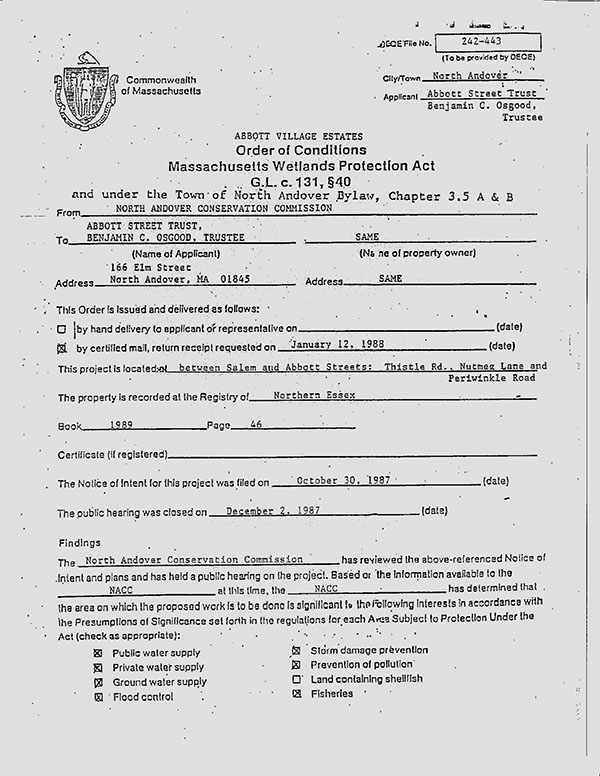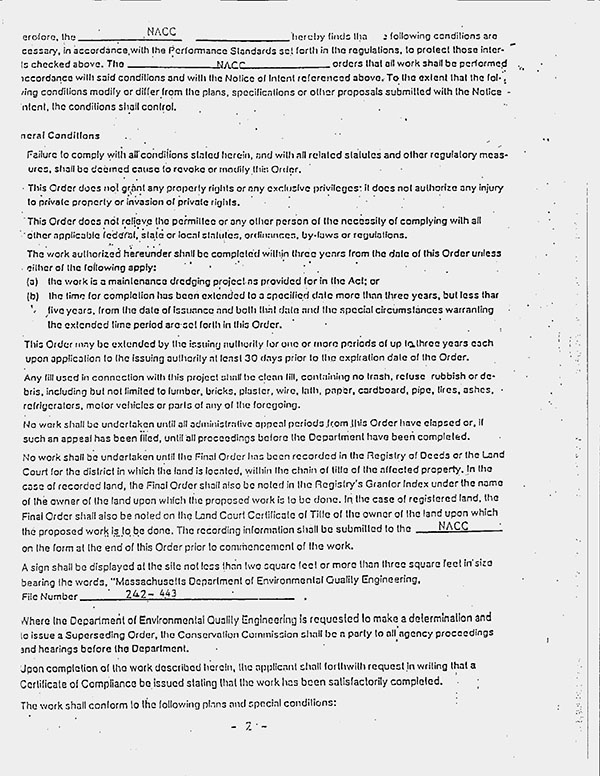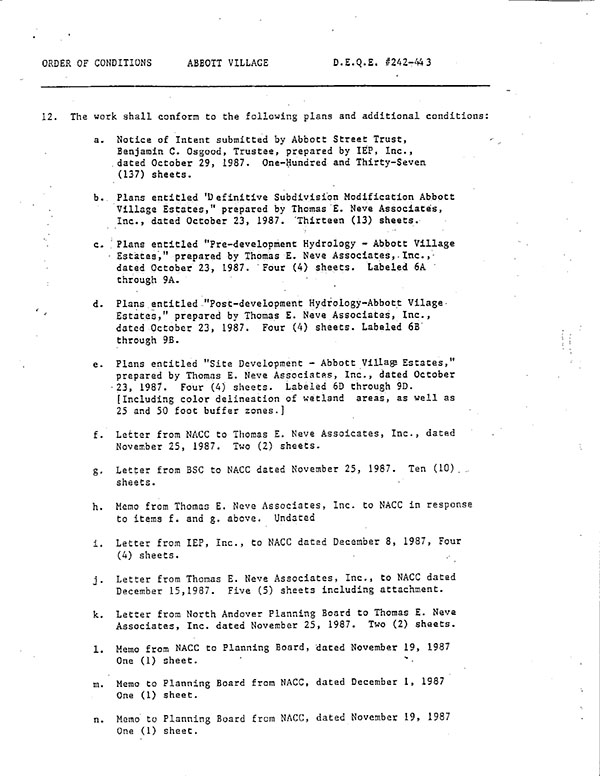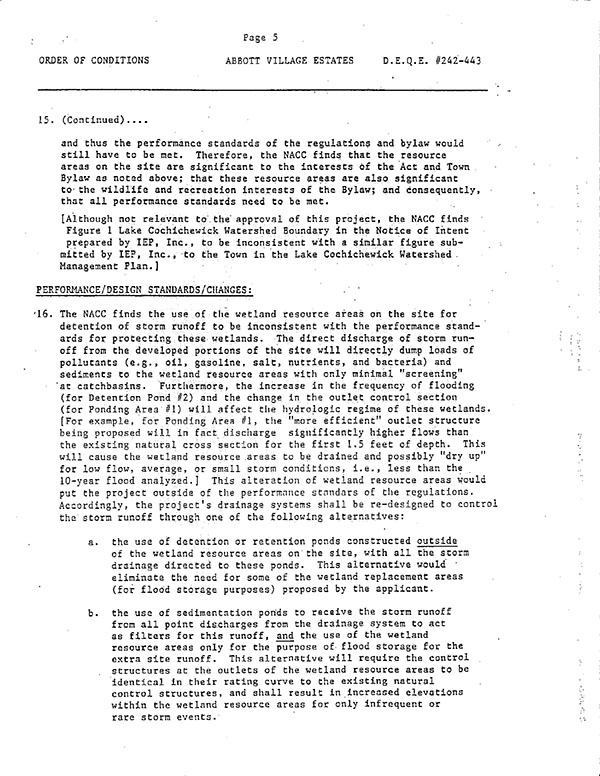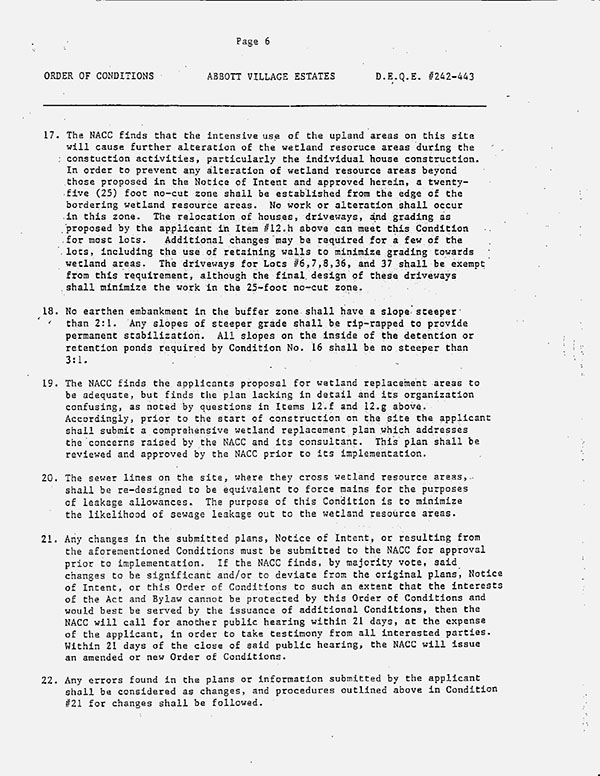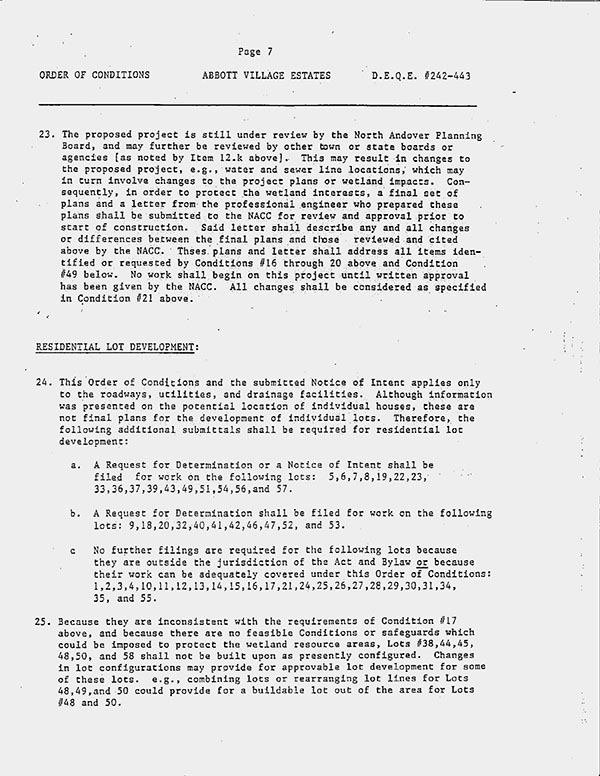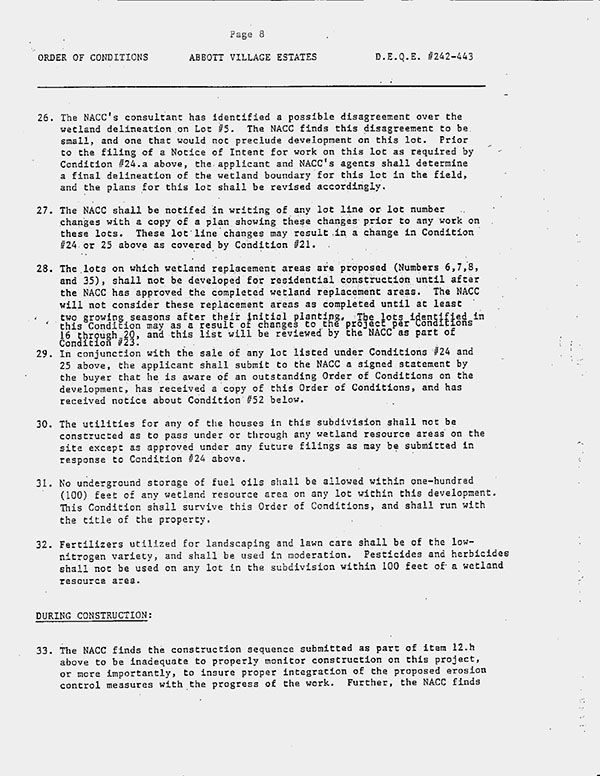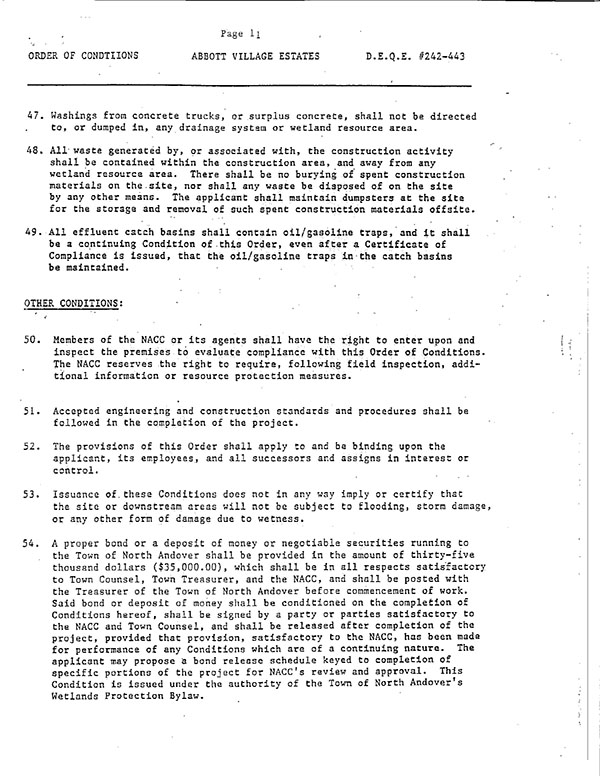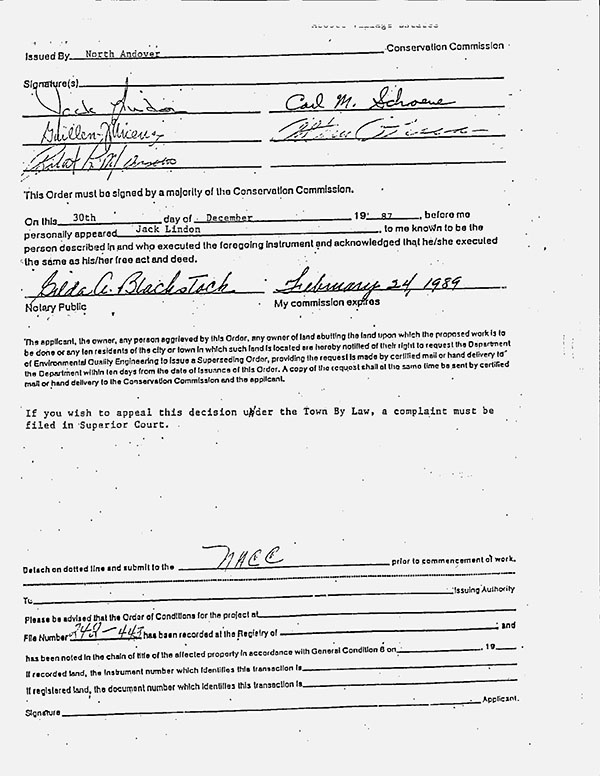On February 25, 1988, Benjamin Osgood, Trustee of Abbott Street Trust ("Plaintiff"), filed a complaint in the Essex County Superior Court seeking certiorari review, in accordance with G.L. c. 249, §4, of a decision of the North Andover Conservation
Commission ("Conservation Commission" or "Commission"), issued on January 12, 1988, wherein the Commission, pursuant to G.L. c.131, §40 and Section 3.5 of the North Andover By-law (Exhibit No. 28), [Note 1] issued an Order of Conditions (sometimes referred to herein as "Order"), a copy of which is attached hereto, relative to the Plaintiff's proposed construction of a 59 lot residential subdivision on a site of approximately 45.62 acres, located off of Salem and Abbott Streets in North Andover ("Abbott Village Project" or "Project"). By this action, the Plaintiff also seeks a declaration, pursuant to G.L. c.231A, as to the respective rights and liabilities of the parties', as they relate to such Order.
By Order of the Chief Administrative Justice, dated April 3, 1989, Land Court Justice, Robert V. Cauchon, was assigned to sit as a Superior Court Jusice for purposes of hearing and determining Superior Court Case No. 88-491. Thereafter, this matter was transferred to the Land Court, where it was consolidated for trial with related Land Court actions. [Note 2]
A trial was held on October 5, 1989, at which time all parties agreed to submit the case on oral arguments of counsel and a stipulation of agreed facts. A certification of the record of proceedings before the Conservation Commission, consisting of some
29 exhibits, was also presented to assist the Court. These exhibits are incorporated herein by reference for purposes of any appeal.
On all of the evidence before the Court, I make the following findings of fact:
1. On October 30, 1987, the Plaintiff filed a Notice of Intent (Exhibit No. 1) with the Conservation Commission, said Notice being submitted in conjunction with the Abbott Village Project.
2. On November 18, 1987, the Conservation Commission held a duly advertised public hearing relative to the Plaintiff's Notice of Intent (See Exhibits No. 22 and 23). Said hearing continued to December 2, 1987, at which time the Commission voted to issue an Order of Conditions within 21 days after receipt of an additional report from the Plaintiff's technical consultant, IEP, Inc. ("IEP") (See Exhibit No. 25 and 26). The Commission received this report on December 8, 1987 (See Exhibit No. 9).
3. The Commission issued an Order of Conditions relative to the Abbott Village Project on January 12, 1988 (See Exhibit No. 28). This Order granted conditional approval to the Abbott Village Project. Of the 56 conditions enumerated therein, the Plaintiff hereby appeals Conditions No. 16, 17, 18, 24, 25, 28, 29, 33, 42, 43, 49, 55 and 56.
The function of a writ of certiorari is not to reverse or revise findings of fact, but to correct errors of law committed by a judicial or quasi-judicial tribunal where such errors appear on the face of the Order and are so substantial and material that, if allowed to stand, they will result in manifest injustice to a petitioner who is without any other available remedy. See Tracht v. County Commissioners of Worcester, 318 Mass. 681 , 686 (1945); Administrator of the Office of Price Administration v. Chook, 320 Mass. 187 , 192 (1946); Howe v. Attorney General, 325 Mass. 268 , 270 (1950); Gifford v. Commissioner of Public Health, 328 Mass. 608 , 619 (1952); Johnson Products, Inc. v. City Council of Medford, 353 Mass. 540 , 541 n.2 (1968). The appropriate standard of review in certiorari cases is to be determined according to the nature of the administrative decision sought to be reviewed and the substantive rules or standards if any, which have been applied. Yerardi's Moody Street Restaurant & Lounge, Inc. v. Board of Selectmen of Randolph, 19 Mass. App. Ct. 296 , 300 (1985); Cepulonis v. Commissioner of Correction, 15 Mass. App. Ct. 292 , 293 (1983); McSweeney v. Town Manager of Lexington, 379 Mass. 794 , 799-800 (1980); Boston Edison Co. v. Boston Redevelopment Authority, 374 Mass. 37 , 49 (1977) ("Authority"). One aggrieved by a decision of a local conservation commission has rights of review under G.L. c.249, §4 for an action of certiorari. See Lovequist v. Conservation Commission of Dennis, 379 Mass. 7 , 9, 16 (1979). In such instances, the Court will uphold the decision of the local conservation commission where it is determined by the Court to have been supported by "substantial evidence" in the record. Lovequist at 18; Boston Edison Co. v. Selectmen of Concord, 355 Mass. 79 , 82 (1968). The "substantial evidence test" is commonly understood to require that the findings of the administrative agency must rest upon such evidence as a reasonable mind might accept as adequate to support a conclusion. Authority at 54. Review under this standard entails scrutiny of the whole record to determine whether "substantial evidence" exists. Id.; Cohen v. Board of Registration in Pharmacy, 350 Mass. 246 , 253 (1966).
A. CONDITION NO. 16
Condition No. 16 requires Osgood to redesign the drainage systems proposed for the Abbott Village Project, on the ground that the systems, as presented to the Commission, will alter wetland resource areas located on the site. In this Condition, the Commission suggests two alternatives for controlling storm runoff, said alternatives being, 1.) the use of detention or retention ponds outside of the wetland resource areas on the site, or 2.) the use of sedimentation ponds to receive such runoff from all points discharging from the system, with the use of the wetland resource areas being restricted to flood storage of extra site-runoff.
Condition No. 16 may evidence a concern which is consistent with the "General Performance Standards" set forth in 310 CMR 10.55 (4) (a), which section states in pertinent part as follows:
... any proposed work in a Bordering Vegetative Wetland ("BVW") shall not destroy or otherwise impair any portion of said area.
I find, however, that the alternatives proposed therein by the Commission are not supported by substantial evidence in the record. On November 25, 1987, the Commission's technical advisor, The BSC Group ("BSC"), submitted a report on the Project to the Commission (See Exhibit No. 7). In such report, BSC addresses the problems at which Condition No. 16 is directed, and concludes as follows:
The detail plans for the proposed "typical catchbasins" do not include oil and gasoline "separator hoods", which if properly maintained, could minimize these impacts to wetlands. However, salt in solution will pass through these basins and into the wetlands, a no salt condition could be considered by the Commission, or alternatively, the catch basin discharges could be confined to compensatory flood storage areas rather than discharged into existing or replacement BVW areas (emphasis added).
This report is devoid of any reference to the corrective measures proposed by the Commission in Condition No. 16. Without citing any significant or compelling reason therefor, the Commission justifies its imposition of these more stringent alternatives by stressing their ultimate impact of "eliminating" the Project's impact on wetlands, as opposed to the mere "minimization" of such impact, as proposed by BSC. The effect of the alternatives proposed by the Conservation Commission in Condition No. 16 is to arbitrarily take away certain portions of the Plaintiff's developable land, for reasons solely associated with the Commission's own preference. Insofar as I note that any degree of land development will ultimately have some effect on wetlands, I find the alternatives suggested by the Commission to be unreasonable and without any logical justification on the record before the Court.
Additionally, I find that the Plaintiff's mere rearrangement of the drainage outlet system proposed for the Project may sufficiently address the Commission's concern with the design of such system, as outlined in Condition No. 16.
B. CONDITION NO. 17
By Condition No. 17, the Commission imposes a twenty-five foot (25') no-cut zone from the edge of the BVW, and declares that no work or alteration of any kind shall occur in such zone. With respect to this Condition, I find that it imposes an unsubstantiated restriction, if not a complete ban, on certain phases of the Plaintiff's proposed development. This is particularly so, in view of the fact that a developer is permitted to perform construction activity, subject to any regulations lawfully imposed thereupon by the Commission, within 100 feet of any BVW located on the site. See By-law Section 3.5 and 310 CMR 10.00 (V) (A) and 10.02 (2) (a). Further, I note that the Conservation Commission, by its own admission, concedes that its imposition of the twenty-five foot (25') no-cut zone "... is obviously not mandated by the evidence before the [Court]", and rule accordingly that such Condition cannot stand when measured against the "substantial evidence test".
C. CONDITION NO. 18
Pursuant to Condition No. 18, "no earthen embankment in the buffer zone shall have a slope steeper than 2:1" and "all slopes on the inside of the detention or retention ponds required by Condition No. 16 shall be no steeper than 3:1". The Plaintiff challenges only the Commission's imposition of the 3:1 slope, which slope the Commission justifies purely on the basis of safety concerns. The Commission does not offer any reason, nor does there appear to be competent evidence in the record, technical or otherwise, that the 2:1 slope is hazardous or that the 3:1 slope reduces such hazard by a degree sufficient to support the imposition of such Condition, particularly in view of available alternatives, such as fencing, etc. Accordingly, I find that, in imposing Condition No. 18 solely on the basis of concerns unrelated to the development of Abbott Village, the Commission rendered a Condition lacking substantial evidence in the record before the Court.
D. CONDITION NO. 24
Condition No. 24 requires the Plaintiff to submit a Request for Determination or a Notice of Intent relative to Lots No. 5, 6, 7, 8, 19, 22, 23, 33, 36, 39, 43, 49, 51, 54, 56 and 57, and a Request for Determination relative to Lots No. 9, 18, 20, 32, 40, 41, 42, 46, 47, 52 and 53. The Commission imposes this requirement on the Plaintiff due to the subject Notice of Intent's limited application to only roadways, utilities and drainage facilities associated with the Project. I find this Condition to be adequately supported by the evidence before the Court, insofar as extrinsic circumstances may later dictate that the Plaintiff reconfigure the present location of some or all of the buildings proposed for construction on each lot. Such a Condition is reasonable, insofar as it is understood that the Commission will dispense with the need for such additional submittals in the event the Plaintiff's final plans mirror those filed herein.
E. CONDITION NO. 25
In Condition No. 25, the Commission states that Lots No. 38, 44, 45, 48, 50 and 58 cannot be built upon as presently configured, due to the absence of any "feasible Conditions or safeguards which could be imposed to protect the wetland resource area" locted on such lots. Neither the report of the Commission's technical consultant, nor any other evidence before the Court, indicates that the probable hazards to the wetlands are of sufficient severity to support the imposition of such a severe means of protecting wetlands in this instance. In this regard, the Plaintiff thus correctly emphasizes the "Summary" portion of BSC's report, which indicates that, pending resolution of a few "details and minor issues", the Abhott Village Project "can go forward in full compliance with the intent of the Wetlands Protection Act, its regulations and North Andover's wetlands by-law".
F. CONDITION NO. 28
Condition No. 28 states that Lots No. 6, 7, 8 and 35 shall not be developed for residential construction until after the Commission has approved the completed wetland replacement areas proposed thereon. In accordance with this Condition, the Commission will not deem these areas "completed", until at least two growing seasons after their initial planting. I find this Condition to be amply supported by the evidence, insofar as it is consistent with 310 CMR 10.55 (4) (b) (6), which provides in pertinent part as follows:
[The Commission] may issue an Order of Conditions permitting work which results in the loss of up to five thousand (5000) square feet of [BVW] when said area is replaced in accordance with the following general conditions and any additional specific conditions the issuing authority deems necessary to ensure that the replacement area will function in a manner similar to the area that will be lost ... at least 75 percent of the surface of the replacement area shall be reestablished with indigenous wetland plant species within two growing seasons....
Further, I find that when one considers the large number of individual houses proposed for construction, and the time which must be allocated to the construction of each, this waiting period of approximately sixteen months presents little, if any, inconvenience to the Plaintiff, while simultaneously providing the Commission with an opportunity to ensure the Plaintiff's proper replacement of certain wetland areas on the site.
G. CONDITION NO. 29
Condition No. 29 requires the Plaintiff to furnish the Commission with a statement, signed by any buyer of a lot in the proposed residential subdivision, indicating that said buyer is aware of the outstanding Order of Conditions, has received a copy of the same and that he or she has received notice of Condition No. 52 of the Order. Inasmuch as the Commission's goal of notifying buyers of the Order of Conditions may be achieved by the recording of such Order in the appropriate Registry of Deeds, I find insubstantial evidence in the record to sustain the Commission's imposition of Condition No. 29.
H. CONDITION NO. 33
Condition No. 33 requires the Plaintiff to submit a revised construction schedule, integrating proposed erosion control measures with the work performed on different portions of the Project, and including phasing of house development to limit disturbances in, and exposures of, the buffer zone. The Commission defends its imposition of the "phasing requirement", by deeming it an assurance "that development of the project will proceed cautiously, in light of the large area of buffer zone that is being disturbed ...". Insofar as I find no evidence in the record to indicate that, in carrying out the Project's proposed construction sequence (See Exhibit No. 8), the Plaintiff will disturb and expose the buffer zone without taking steps, short of "phasing" construction, to minimize such impact, or that such steps will not adequately protect the buffer zone, this Condition must be stricken. Moreover, I note that, as discussed in further detail below, 310 CMR 10.55 (4) already requires that the Plaintiff replace disturbed BVW areas, implicitly with either equivalent or better wetlands.
I. CONDITION NO. 42
The Plaintitf objects herein to only that portion of Condition No. 42 which is underlined below:
After proper grading, all disturbed areas located within a resource area which will not remain as wetland areas, shall be loamed and seeded with not less than four (4) inches of good quality loam. Before seeding, ground limestone shall be applied at a rate sufficient to bring the soil test to pH 6.5. In addition, 10-6-4 fertilizer, or its equivalent, shall be applied at a rate of fifteen (15) pounds per one-thousand square feet, in accordance with Soil Conservation Service guidelines....
Although the Commission rightfully asserts herein that this Condition ensures "that wetlands are either properly restored to their original condition or properly filled, acid-neutralized, fertilized and seeded", I find that the Plaintiff's obligation with respect to the replacement of such areas is adequately set forth in 310 CMR 10.55 (4), which requires the replacement areas "to function in a similar manner to the area (lost]". Such requirement implies that the replacement soil be acid-level and fertilized to achieve a state comparable to its original one. Accordingly, I find Section 10.55 (4) to sufficiently address the Commission's concerns, and rule that the specific requirements which the Commission imposes upon replacement fertilizers and acid-neutralizers lack support in the record.
J. CONDITION NO. 43
Without giving any reason whatsoever relative to wetlands impact, the Commission imposed Condition No. 43, requiring that "no exposed area shall remain unfinished for more than thirty (30) days, unless approved by the [Commission] or its agent". The Commission does not define the parameters of the phrase "exposed area", nor does it explain the significance or need for such Condition in view of wetland concerns. I thus find that this Condition amounts to nothing more than an unsubstantiated conclusion, which cannot be sustained on the record before the Court.
K. CONDITION NO. 49
Condition No. 49 reads as follows:
All effluent catch basins shall contain oil/gasoline traps, and it shall be a continuing Condition of this Order, even after a Certificate of Compliance is issued, that the oil/gasoline traps in the catch basins be maintained.
310 CMR 10.05 (9) (e) provides in pertinent part, as follows:
If the final [Order] contains conditions which continue past the completion of the work, such as maintenance or monitoring, the Certificate of Compliance shall specify which, if any, of such conditions shall continue....
This DEP regulation implies that the Commission may rightfully impose certain conditions upon a developer, which conditions, if they are classifiable as either "maintenance" or "monitoring", may survive the issuance of the Certificate of Compliance. Accordingly, I find that, as Condition No. 49 involves a maintenance activity, it is supported by applicable DEP regulations and must be sustained on the record before the court.
L. CONDITION NO. 55
Condition No. 55 requires that the Plaintiff furnish the Conservation Commission with a letter from a registered professional civil engineer, certifying compliance with the Order of conditions. This Condition also requires that the Plaintiff submit an "As Built" topographic plan of all areas within the jurisdiction of the Act and By-law, at the time when such Certificate is requested. I find the Commission's requirement with respect to certification from a registered professional civil engineer to be supported by the evidence before the Court, and by applicable DEP regulations. For example, 310 CMR 10.05 (9) (d) states in relevant part, as follows:
If a project has been completed in accordance with plans stamped by a registered professional engineer ... a written statement by such a professional person certifying substantial compliance with the plans and setting forth what deviation, if any, exists from the plans approved in the Order shall accompany the request for a Certificate of Compliance.
The Commission's first request is consistent with this regulation, insofar as the Plaintiff's plans are in fact stamped by a registered professional civil engineer. Further, I find the Conservation Commission's request for an "As Built" topographical plan to be consistent with this regulation as well, but note that the Plaintiff should be under no such obligation in the event the completed Abbott Village Project reflects the plans then before the Commission, and the registered professional civil engineer so certifies (ie. "there are no changes from the plan as approved by the Commission").
With respect to this Condition, I also note the Plaintiff's position that "partial certificates" should be issued as certain portions of the Project are completed. In this regard, I find that the Commission appears in its arguments to endorse the Plaintiff's request, as it states, "... if the request is for a partial certificate of Compliance, the information required need be submitted only with respect to the activities to be covered by that Certificate of Compliance".
M. CONDITION NO. 56
By Condition No. 56, the Commission states that Conditions No. 31, 32, 46 and 49 shall survive the issuance of a Certificate of Compliance for the Project. As to Condition No. 31, which prohibits the underground storage of fuel oils within 100 feet of any wetland resource area located on the subdivision lots, I find the survival of such Condition to be substantiated on the record, inasmuch as it involves the "maintenance" of wetland areas. Similarly, I find that portion of Condition No. 32, which refers to the usage of pesticides and herbicides within 100 feet of any wetland resource area, to be substantiated on the record as a "maintenance" activity. In addition, I note that, in any event, the Plaintiff's obligation to replicate wetland areas which are altered or destroyed during construction would serve as a similar ban on the usage of such chemicals. I do not, however, find sufficient justification in the record for the Commission's requirement in Condition No. 32 that, even after the issuance of the Certificate of Compliance, any "fertilizers utilized for landscaping and lawncare shall be of low-nitrogen variety, and shall be used in moderation". This Condition is not directed at the protection of wetland areas, nor is it application imposed upon the developer in the course of developing the Abbott Village Project. Accordingly, this portion of Condition No. 32 must be stricken from the Order of Conditions.
With respect to the survival of Condition No. 46, I find that the Commission's requirement that there be "no discharge or spillage of fuel, oil or other pollutants into any wetland resource area" is amply warranted by the evidence as another "maintenance" activity. Finally, for the reasons enunciated above, I find that Condition No. 49 may also survive justifiably as a Condition, following the issuance of a Certificate of Compliance.
In consideration of the foregoing, I rule in summary that the following Conditions, which were imposed by the North Andover Conservation Commission upon the Plaintiff's Abbott Village Project, are supported by substantial evidence in the record before the Court and, accordingly, must be sustained:
1.) Condition No. 24
2.) Condition No. 28
3.) Condition No. 55
4.) Condition No. 56, with the exception of that portion of the Condition relative to the survival of the condition concerning the use of low-nitrogen fertilizers in landscaping and lawncare.
Conditions No. 16, 17, 18, 25, 29, 33, 42, 43 and 49 must be stricken from the Order of Conditions, insofar as they lack substantial evidence in support thereof in the record before the Court.
Judgment accordingly.
 BENJAMIN OSGOOD, TRUSTEE OF ABBOTT STREET TRUST vs. JACK LINDON, GUILLERMO VICENS, ROBERT MANSOUR, ARTHUR RESCA, LOUIS BRUINOOGE and CARL SCHOENEY, as they are the members of the NORTH ANDOVER CONSERVATION COMMISSION.
BENJAMIN OSGOOD, TRUSTEE OF ABBOTT STREET TRUST vs. JACK LINDON, GUILLERMO VICENS, ROBERT MANSOUR, ARTHUR RESCA, LOUIS BRUINOOGE and CARL SCHOENEY, as they are the members of the NORTH ANDOVER CONSERVATION COMMISSION.
